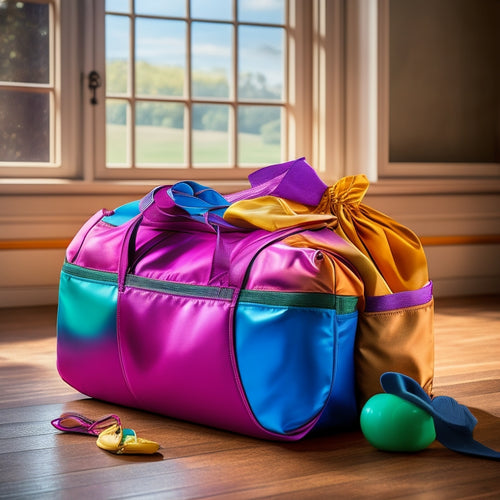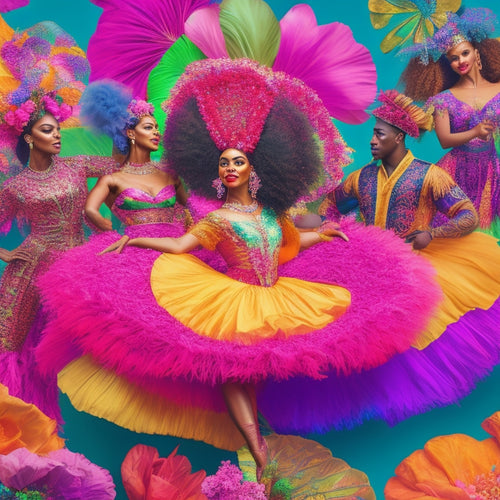
10 Essential Dance Makeup Design Tutorial Tips
Share
To master dance makeup design, you'll need an in-depth understanding of color theory, high-quality tools, and skin tone identification. Create a flawless base layer with primers and moisturizers, and enhance facial features naturally with shading and highlighting techniques. Consider the dance genre, balancing bold and subtle looks, and prepare for high-energy performances with sweat-proof formulas and oil-controlling foundation. Be ready to troubleshoot common makeup malfunctions efficiently. By following these essential dance makeup design tips, you'll be well on your way to elevating your performance - and that's just the beginning of perfecting your stage presence.
Key Takeaways
• Identify the dance genre to tailor makeup design, using bold colors for hip-hop and jazz, and soft hues for ballet and contemporary.
• Balance bold and subtle elements in makeup design, considering stage lighting and the dancer's persona.
• Use high-quality, sweat-proof, and long-lasting formulas to ensure makeup stays intact during high-energy performances.
• Create a flawless base layer with primers and moisturizers, and enhance facial features naturally with shading and highlighting techniques.
• Troubleshoot common makeup malfunctions efficiently, keeping spare lashes and lash glue on hand for quick fixes.
Mastering Dance Makeup Color Theory
When crafting a dance makeup design, understanding the fundamentals of color theory is crucial. It allows you to select harmonious hues that complement the dancer's skin tone, costumes, and overall aesthetic. This knowledge empowers you to create a cohesive look that enhances the dancer's features and amplifies their performance.
To achieve color harmony, you'll want to take into account the 60-30-10 rule, where 60% of the design consists of a dominant color, 30% a secondary color, and 10% an accent color. This ratio creates balance and visual appeal.
When building your palette, focus on analogous colors, which are next to each other on the color wheel, or complementary colors, which are opposite each other. This will ensure a harmonious and visually stunning design.
Selecting the Right Makeup Tools
When it comes to creating stunning dance makeup designs, you'll need the right tools for the job. You're about to learn the importance of selecting high-quality brushes, understanding their specific uses, and why investing in superior tools will elevate your artistry.
Brush Selection Essentials
You'll need a range of high-quality brushes in various shapes and sizes to achieve a flawless dance makeup design, as the right tools can make all the difference between a mediocre and a mesmerizing look. When selecting your brushes, consider the type of makeup you'll be applying, the surface area you're working on, and the level of precision required.
To guarantee your brushes remain in top condition, you'll need to:
-
Clean your brushes regularly to prevent the buildup of bacteria and old makeup, which can affect the quality of your application and even cause skin irritation.
-
Store your brushes in a cool, dry place, away from direct sunlight, to prevent damage to the bristles and ferrule.
-
Organize your brushes by type and size, making it easier to find the right tool for the job and preventing clutter in your makeup bag.
Pro Makeup Brush Uses
Selecting the right makeup tools is essential to achieving a professional dance makeup design, and starts with understanding the unique functions of each brush type. You'll want to familiarize yourself with the various brushes in your kit, including foundation, concealer, powder, blush, and eyeshadow brushes.
Each brush is designed for a specific task, and using the right one can make all the difference in the quality of your makeup application.
When it comes to pro makeup brush uses, you'll want to take into account the bristle material, shape, and size. Natural bristles are ideal for powder and blush, while synthetic bristles work best for cream and liquid products. Angled brushes are perfect for precise application, while flat brushes are better suited for broad coverage.
Proper brush cleaning and storage are also vital. Clean your brushes regularly with a gentle soap and lukewarm water, and store them in a protective case to prevent damage.
Tool Quality Matters
With your brush arsenal in order, it's time to focus on the quality of your makeup tools, as a high-caliber product can make all the difference in achieving a flawless, camera-ready finish for your dance makeup design.
When it comes to selecting the right tools, remember that investing in high-quality products is vital. A good makeup investment isn't just about the initial cost, but about the longevity and performance of the product.
Here are three key factors to keep in mind when evaluating the quality of your makeup tools:
-
Brand Reputation: Research the brand's reputation and read reviews from other users to make sure you're investing in a reputable product.
-
Material Quality: Look for tools made from high-quality materials that will withstand repeated use and cleaning.
-
Performance: Take into account the tool's performance and how it will help you achieve the desired finish for your dance makeup design.
Understanding Skin Tones and Types
Your skin tone and type serve as the foundation of your dance makeup design, and understanding these fundamental characteristics is essential for creating a look that enhances your natural beauty.
When it comes to skin tone, you'll want to examine your undertones, which can be cool, warm, or neutral. Cool undertones have a pink or blue base, warm undertones have a yellow or golden base, and neutral undertones are a balance of both. To determine your undertones, analyze the veins on the inside of your wrist. If they appear blue or purple, you have cool undertones. If they appear green, you have neutral undertones. If they appear yellow or golden, you have warm undertones.
In addition to understanding your skin tone, you'll want to assess your complexion. This involves identifying your skin type, whether it's normal, oily, dry, or combination. You'll also want to take into account your skin's natural texture and any areas of concern, such as acne, hyperpigmentation, or fine lines.
Creating a Flawless Base Layer
To achieve a flawless base layer, you'll need to prime your skin with a high-quality primer that suits your skin type, as this essential step helps create an even canvas for your dance makeup design. A well-prepped skin is vital for a long-lasting and flawless makeup look.
Before applying primer, make sure you've completed your moisturizing routine and skin prep. This will guarantee your skin is hydrated and ready for makeup.
Here are three key tips to keep in mind:
-
Choose the right primer: Select a primer that complements your skin type, whether it's oil-controlling, hydrating, or illuminating.
-
Apply primer correctly: Use a gentle, sweeping motion to apply primer, making sure to cover all areas of your face.
-
Allow primer to set: Give your primer a few minutes to absorb and set before applying foundation or other makeup products.
Enhancing Facial Features Naturally
When you're enhancing your facial features naturally, you'll want to focus on highlighting your natural assets and softening facial lines. By doing so, you'll create a balanced, radiant look that's perfect for the stage.
You'll learn how to accentuate your best features and subtly conceal any imperfections, resulting in a confident, polished appearance.
Highlight Natural Assets
By accentuating your best facial features, you can create a stunning dance makeup design that exudes confidence and sophistication. Highlighting your natural assets allows you to enhance your facial structure, creating a radiant and polished look that shines on stage.
To achieve this, focus on the following key areas:
-
Brightening Complexions: Use a lightweight foundation or tinted moisturizer that matches your skin tone to even out your complexion and create a natural-looking base. This will help to reduce the appearance of blemishes and imperfections, allowing your natural beauty to shine through.
-
Defining Features: Accentuate your features by using subtle shading techniques to create definition and depth. Use a bronzer or contour powder to add warmth and dimension to your face, and define your brows to frame your eyes.
-
Enhancing Facial Shapes: Emphasize your facial shape by accentuating your cheekbones, nose, and jawline. This will help to create a more defined and sculpted appearance, adding depth and dimension to your overall look.
Soften Facial Lines
You'll want to soften facial lines to create a more youthful, radiant appearance that complements your highlighted natural assets.
As a dancer, you know that a smooth, lineless complexion is essential for a flawless performance. To achieve this, incorporate facial massage into your pre-performance routine. Gently massage your forehead, cheeks, and chin in circular motions to increase blood flow and relax facial muscles. This will help reduce the appearance of fine lines and wrinkles, giving you a more youthful and radiant glow.
When applying makeup, use a light hand when applying products to areas with deep lines or wrinkles. Instead, focus on building coverage gradually, layer by layer, to create a seamless finish. Avoid heavy foundation or concealer, as this can accentuate lines and wrinkles. Instead, opt for a lightweight, buildable formula that blends effortlessly into the skin.
Using Makeup to Accentuate Movement
To maximize the visual impact of your dance performance, strategically applied makeup can amplify the dynamics of your movements, drawing the audience's attention to specific body parts or gestures. By accentuating key areas, you can create a visual narrative that complements your choreography.
To achieve this, focus on the following techniques:
-
Dynamic Shadows: Use darker shades to create depth and dimension on your skin, emphasizing the curves and contours of your muscles as you move. This will create a sense of power and energy.
-
Kinetic Highlights: Apply lighter shades to highlight areas that will catch the light as you move, creating a sense of fluidity and dynamism.
-
Accentuated Joints: Emphasize your joints (e.g., elbows, knees, ankles) with subtle shading or highlighting to draw attention to the intricate movements of your body.
Designing Makeup for Different Genres
When preparing to design makeup for different dance genres, you'll need to take into account the unique characteristics of each style. For ballet and contemporary, you'll focus on enhancing the dancer's natural features while maintaining a clean, elegant look.
In contrast, hip-hop and jazz require bold, vibrant colors and edgier designs that can keep up with the high-energy performances.
Ballet and Contemporary
In the world of ballet and contemporary dance, your makeup design should evoke an ethereal, otherworldly quality, with soft, delicate hues and subtle shading that harmonize with the dancer's costume and the performance's overall aesthetic. You want to create a look that's Pointe Perfect, Contemporary Chic - a fusion of elegance and modernity.
To achieve this, focus on enhancing the dancer's natural features without overpowering their performance.
Here are three essential tips to keep in mind:
-
Soft Focus: Opt for sheer to medium coverage foundation that matches the dancer's skin tone, allowing their natural complexion to shine through.
-
Whisper-Worthy Hues: Choose soft, muted shades for eyes, lips, and cheeks that complement the costume and performance colors.
-
Luminous Glow: Apply a subtle highlighter to accentuate the dancer's bone structure, creating a radiant, ethereal glow.
Hip-Hop and Jazz
When designing makeup for hip-hop and jazz performances, you'll want to create a bold, dynamic look that pops under bright stage lights, amplifying the dancer's confidence and energy. These high-energy genres demand a makeup design that's edgy, urban, and unapologetic. Think Streetwear Chic with a dash of Funky Fusion.
To achieve this look, focus on bold colors, graphic lines, and statement pieces. Here are some key elements worth noting:
| Feature | Technique |
|---|---|
| Eyes | Smoky eyes with bold, bright shades and graphic liner |
| Lips | Bold, bright lip colors that pop under stage lights |
| Skin | Natural, radiant base with subtle highlighting |
Balancing Bold and Subtle Looks
You'll need to master the art of balancing bold and subtle looks to create a cohesive dance makeup design that complements the performer's costume and stage lighting. As a dancer, your dance persona is an essential aspect of your performance, and your makeup design should reflect that.
When balancing bold and subtle looks, consider the following key elements:
-
Highlighting key features: Accentuate your best features, such as your eyes or lips, with bold colors or dramatic shapes to create a striking focal point.
-
Softening the overall look: Balance bold features with softer, more subtle shades to prevent overwhelming the audience.
-
Considering stage lighting: Take into account how stage lighting will impact your makeup design, adjusting your look to make sure it translates well under different lighting conditions.
Makeup for High-Energy Performances
For high-energy performances, you'll need a makeup design that not only complements your dance persona but also withstands the intense physical demands of your routine. To achieve this, focus on using sweat-proof formulas that can keep up with your energetic movements. Look for products labeled 'long-lasting' or 'water-resistant' to guarantee your makeup stays in place even when you're sweating profusely.
When selecting products, prioritize those that provide excellent coverage without feeling heavy or cakey on your skin. This will help you maintain a natural, radiant look even under the intense stage lights. Consider using a lightweight, oil-controlling foundation that won't budge despite your high-energy performance.
To amplify your stage presence, focus on accentuating your features with bold, vibrant colors. Use a bright lip color or a bold eye shadow to capture the audience's attention. Remember, your makeup design should enhance your performance, not overshadow it.
Quick Fixes for Common Mishaps
In the heat of the performance, smudged eyeliner, broken false lashes, or misplaced glitter can quickly ruin your polished look, but having a few quick fix tricks up your sleeve can save the day.
When makeup malfunctions strike, every second counts, and knowing how to troubleshoot common mishaps can be the difference between a flawless performance and a beauty blunder.
Here are three quick fixes to get you back on track:
-
Emergency concealment: Keep a small concealer in your kit to cover up smudges or blemishes. Apply a small amount with a precision brush to target the affected area.
-
Quick drying: Use a setting spray to set your makeup and prevent smudging or smearing. This is especially useful for eyeliner and lipstick.
-
Fast fixes for lashes: Bring a spare set of lashes and a lash glue to replace broken or misplaced lashes. For a quick fix, use a lash glue to reattach a stray lash or secure a loose corner.
Frequently Asked Questions
How Do I Remove Stubborn Makeup Without Damaging My Skin?
When removing stubborn makeup, you'll want to use micellar water to gently dissolve products, then follow up with gentle exfoliation to sweep away residue, ensuring a clean slate without damaging your skin.
Can I Use Everyday Makeup Products for Dance Performances?
As you step into the spotlight, you wonder if your everyday makeup will suffice for the stage. Unfortunately, it won't provide the same level of durability and visibility as a dance foundation, which is essential for maintaining a strong stage presence.
Are There Specific Makeup Products for Sensitive Skin?
When shopping for dance makeup, you'll want to opt for hypoallergenic options specifically designed for sensitive skin, featuring soothing ingredients that calm and comfort your skin, ensuring you feel liberated to shine on stage.
How Long Does It Take to Master Dance Makeup Design?
You'll need patience and a significant time investment to master dance makeup design - expect to dedicate several months to a year of consistent practice to develop your skills and achieve proficiency.
Can I Reuse Makeup Brushes After Cleaning Them?
As you hold the reins of your artistic expression, you wonder: can I reuse makeup brushes after cleaning them? Absolutely, you can, but only if you've mastered Brush Sanitizing, ensuring peak Makeup Hygiene, and freedom from bacterial buildup.
Related Posts
-

Why Digital Solutions Are a Game-Changer
By integrating digital solutions into your operations, you can revolutionize your workflows, discover new revenue str...
-

Dancewear Bags to Keep You Organized and Stylish
When it comes to dancewear bags, you want something that's both functional and stylish. Look for durable materials li...
-

Dance Dress Code: Unleash Your Style
A dance dress code that prioritizes functionality and technical precision can often stifle dancers' ability to expres...


